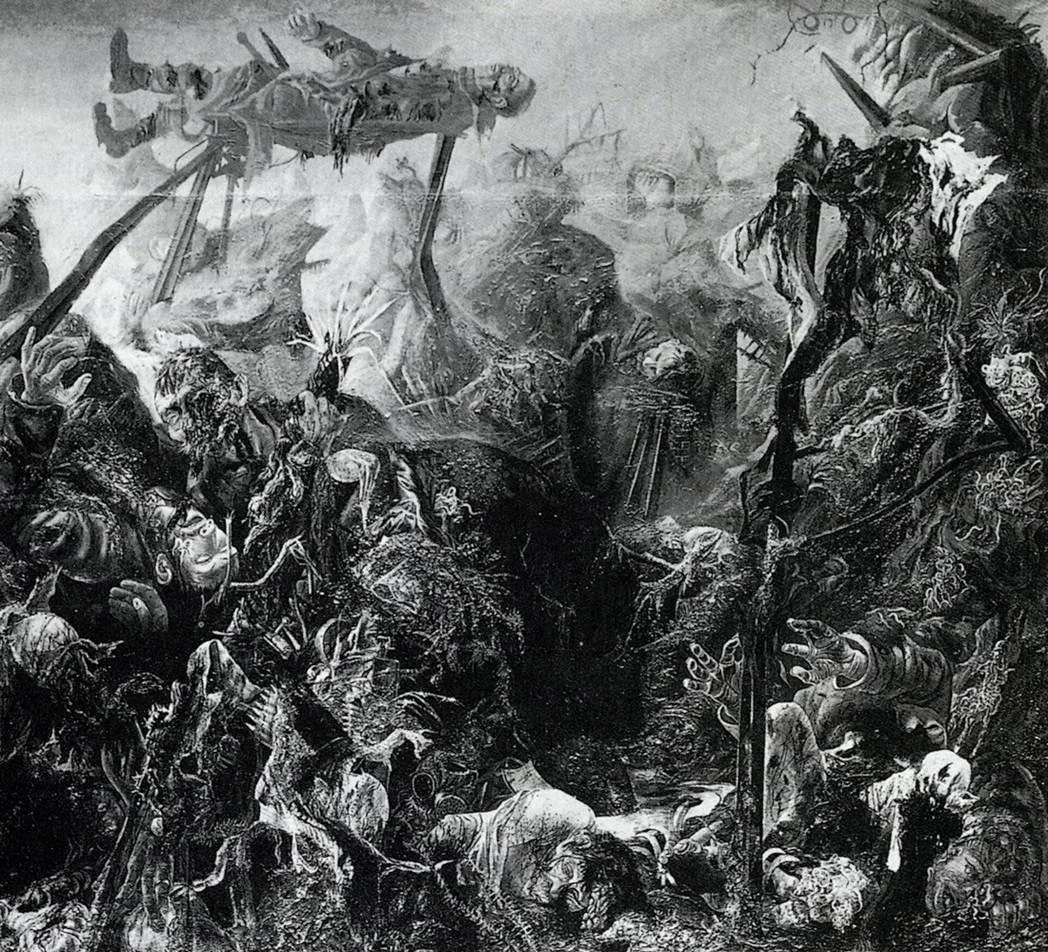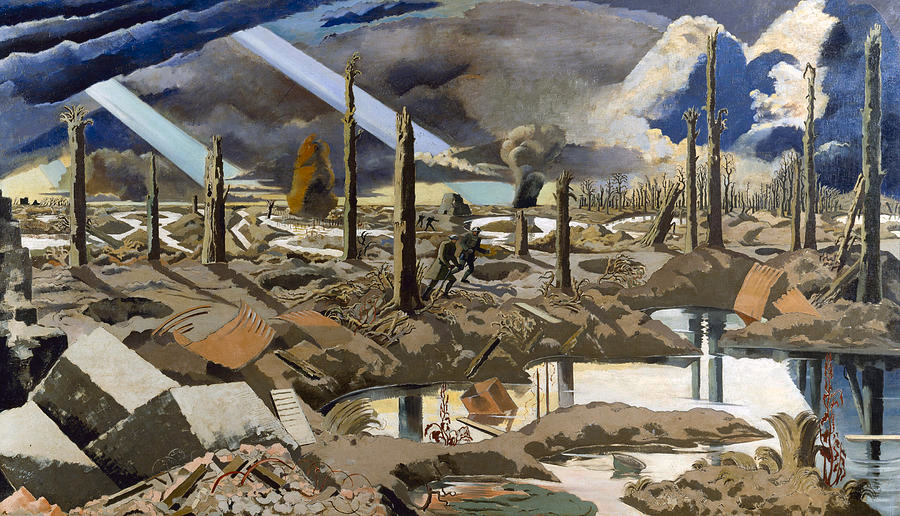Early Modern Blog Exhibit - The Influence of World War One
Early Modern Blog Exhibit - The Influence of World War One
Introduction
The topic I will be covering in this week's installment, is something that is of both great importance to me and early modern art, World War One. As I’ve stated in previous posts, I’m a huge fan of both reading and history. So, even from a young age, I’ve loved to read everything I could involving the first world war. How does this relate to art, you might ask? Well, I was first introduced to this volatile era through an artistic medium in the form of Nathan Hale’s Hazardous Tales.
I know I have talked about Mr. Hale and his work before, but I cannot stress enough just how amazing and eye-opening reading his books were for me. As always, I recommend anyone with some interest to take a look at his excellent illustrations and storytelling, in the case of World War One, Treaties, Trenches, Mud, and Blood.
World War One and Early Modern Art
World War One was such a calamitic event that it left a mark on history that can still be seen and felt today. As is generally the case during times of war, everything from technology to science took leaps and bounds forward. Men rode in on horses carrying bolt action rifles and left in tanks fitted with machine guns. This advancement and change wasn’t just strictly held to war related crafts, however, but also touched the art of the early modern era. The over-the-top and boisterous nationalism that can be seen at the beginning of the era was replaced by more subdued and sorrow-filled works reminiscent of the terrible fighting that had lit the world on fire. Numerous artists that rose into the spotlight following the war had served, giving their works added depth and realism. However, words can only do so much, it is now time to display the first work of this exhibit, The Trench.
The Trench
The Trench, “created by German artist Otto Dix while he was in Dresden in 1923 depicts the terrible result of trench warfare” (Art Culture). Otto is a great example of a soldier turned artist and how they can educate the masses on the horrors of combat. Otto served in the German Army fighting on both Eastern and Western Fronts as a machine gunner. He spent much of this time engaging in brutal trench-based combat, giving him the inspiration for this staggering piece. Although the painting is lost to the sands of time today, even pictures of it evoke incredibly powerful emotions.
When first looking at the piece, I can’t help but feel both the horror and desolation of the situation. This level of detail and realism is only possible because of Otto Dix living through what he portrayed. Texture was something that instantly jumped out to me upon going over Dix’s work. This is on great display on everything from the war-torn ground, weathered structures, and fallen bodies. Because of the black and white nature of this work, tone is another element that is front and center. Otto’s expert utilization of this results in a dramatic and depth filled landscape. Finally, the employment of jagged lines to further the emotions of fear and turmoil bring the piece to its fitting conclusion.
The Merlin Road
Next, we will be looking at a personal favorite of mine from this era, The Merlin Road. “The Merlin Road was painted by Pual Nash in 1919, Great Britain, with dimensions of 1828mm (about 6 ft) by 3175mm (about 10.5 ft) and is currently stored in the Imperial War Museum” (IWM). This work is another that features the unfettered destruction and brutality of war. This scene, expertly depicted by Pual Nash, shows the wrecked and battle-scared landscape of the road between Ypres and Menin.
Something that I really enjoyed when viewing this piece was how it felt oddly peaceful. Although action can be seen on the canvas, the scene feels almost as if a lull in the fighting had occurred during its depiction. The light breaking through the clouds and mixing with the demolished expanse makes for a strange but masterful piece. A huge reason for this is the deft use of tone to contrast the shafts of sunlight with the darker landscape, resulting in an ethereal appearance. Another element that jumped off the canvas for me was Pual’s excellent utilization of color. Everything from the muted brown of the mud to the blue in the sky combined making the work vivid and real to me. Lastly, shape made an interesting and powerful appearance in The Menin Road. Although I personally didn’t notice this element at first glance, after looking closer I can now see its impact. It can be seen in the multitude of broken-down material and equipment that occupies the front of the canvas, adding additional profundity to the work.
The Cornfield
The final piece in this virtual exhibit, although differing from the others, still shares a heavy influence from the war. “The Cornfield, painted by John Nash in 1918 New England, measures 68.6 by 76.2 cm and resides in the Chalfont Common Museum” (Art UK). What makes this painting so special to me, is how it is the perfect example of every coin having two sides. Not only does it show rejuvenation and fresh hope following the Great War, but it is also painted by the brother of Pual Nash. When looking at the two works side by side, it hard to imagine that they were painted in the same era, yet alone by siblings. These staggering differences, however, perfectly represent the time period after the war.
The artistic elements of The Cornfield equally match the rich ideological background and meaning the piece conveys. This can be seen in the vivid utilization of color with the green and golden hues making the canvas feel inviting and alive. As well as the curved line along the horizon furthering the ideas of comfort and ease. While the pattern of the fields and trussed wheat further these ideas.
Conclusion
Overall, this blog was both fun and informative to tackle. I hope everyone else enjoyed this process as much as me. Not only did this assignment give me some new artists to research but it also provided me with an appreciation of early modern art that I otherwise wouldn’t have gained. Thanks for reading and see you all next time!
Sources
Art Culture. (n.d.). The Trench. Retrieved from https://www.artandpopularculture.com/The_Trench
Art UK. (n.d.). The Cornfield. Retrieved from https://artuk.org/discover/artworks/the-cornfield-200986
IWM. (n.d.). The Menin Road. Retrieved from https://www.iwm.org.uk/collections/item/object/20087







I like your third work the most. It is hard for me to get past the war themes of the other selected works, and just appreciate the art elements. "The Merlin Road" has some nice colors, and 'The Trench" is terrifying to look at. I think you talk about the war differently with each piece, which creates a journey through your blog. I can't tell for sure, but I feel like "The Merlin Road" has two-point perspective. My eyes can't focus on these two points like they should, but it certainly seems like the soldiers are at the front of the scene, and it fades back near each side.
ReplyDeleteHi Vaughan!
ReplyDeleteThe Merlin Road is especially moving. I can see why you think it peaceful. Compared to some other works, the earthy tone mixed with the blue/yellow sky has a tendency to calm my senses. In sharp contrast, the not-so-empty space between the trees filled with debris and craters really brings home just how awful trench warfare was. This is a moving piece. Thank you for sharing.
Vaughan,
ReplyDeleteI wanted to add to your first piece displayed as I also did pick a piece from Dix, I believe he does a great job in displaying horror and discomfort as he too was in the front lines of battle before he became an artist. When viewing this piece it's hard to focus on what is a very busy canvas. I can't quite make out what's happening but it's filled with death and strong emotions of grief and loss.
Hi Vaughan,
ReplyDeleteI found your blog post about the early modern art era really insightful and engaging. The way you discussed the evolution of artistic techniques and styles during that period was fascinating. I especially appreciated your analysis of the social and cultural influences on the art of that time. Looking forward to reading more from you on this topic! Keep up the great work!
I found the second work in your blog particularly compelling. The way you depict the emotions and impact of war in this piece resonates deeply. While the other works also address these themes powerfully, the second one stands out to me. It captures a certain rawness and intensity that is hard to overlook. The use of color and perspective adds a unique depth to the scene, making it a striking piece. Your exploration of the war's influence on art is thought-provoking and well-executed
ReplyDelete